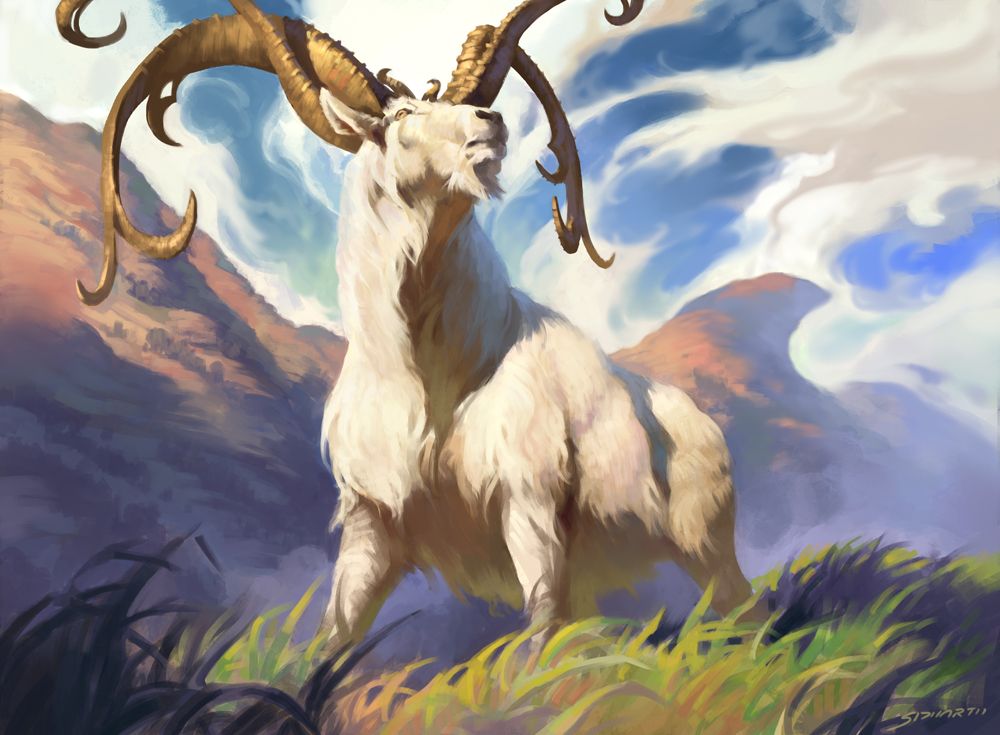Zhuptik
Poram's eyes widened in fear as she head the thundering footsteps of the Gish cavalry. With great speed, the warriors ascended over the hill, riding atop large and imposing beasts with gnarled, twisting horns that could skewer even the toughest warrior.The zhuptik is the staple mount of Reish. Domesticated sometime in the 2000s BW in southern Shivish, usage of the goat-like beasts quickly spread around the region, from the Nonapi plateaus to the vast plains of the Betlao Empire. Used for both transportation and battle, the zhuptik are very deeply tied to the politics, war, and economies of the Reish region. Nations with monopolies on zhuptik breeding and trade can easily become very rich, or very powerful.
Basic Information
Anatomy
Zhuptik are large, goat-like beasts with four legs, two horns, and eyes with horizontal pupils. The horns of a zhuptik vary wildly in shape and size, from small, almost nub-like horns found in desert zhuptik, to the large and gnarled horns found in Gish zhuptik.
The wool color of a zhuptik varies, but they are usually a solid white, black, or gray. Some zhuptik in the south have brown wool, but they are much rarer even in areas where they exist. Occasionally, a zhuptik is born with two wool colors, which is considered a good omen by zhuptik breeders. Colors aside, a zhuptik's wool is very thick and useful for clothing production, although the less irritable and faster-breeding Basu are more often used for that purpose.
Zhuptik are also known for their tough hooves and powerful kicking strength, which can easily kill a man if the zhuptik has a good shot. Zhuptik, especially war zhuptik, are often bred for the strongest legs and toughest hooves.
Genetics and Reproduction
Zhuptik, like all mammals, reproduce sexually. Female zhuptik give birth after 6 months to one or two kids.
Growth Rate & Stages
Once born, zhuptik mature over a process of four years. Their horns begin to appear halfway through the second year, slowly growing with them as they continue to mature. Once they become adults, zhuptik are able to live away from their parents and be used elsewhere as a means of transportation or a cavalry mount. This is also seen in the wild, where adult zhuptik will break off from their family's herd on occasion and start their own. Despite that, zhuptik have been known to return to their parents, showing a sort of intelligence unexpected of such a beast.
Ecology and Habitats
Zhuptik first originated in the more hilly areas of Shivish, but as they've become domesticated, their habitat of choice has shifted to vast plains, even in the wild, seen in the wild Okrif zhuptik that live in the Okrif Plains.
While most zhuptik are primarily herbivorous, they aren't beyond consuming meat if desperate, but they don't hunt. Despite not being a predator, zhuptik are often feared by other animals in whatever region they inhabit, since they are fierce opponents if attacked.
Biological Cycle
In spring, a zhuptik will shed much of its wool rapidly in order to stay warm as it begins to cool off. In the north of Gishik, where spring is heralded by powerful winds, often mark the beginning of spring when they find large amounts of scattered zhuptik hairs carried by the wind. They refer to this event as "Oktazhu", or "Woolspring".
Additional Information
Uses, Products & Exploitation
Zhuptik are mostly used for two things: transportation of people, and as cavalry mounts. Many households make use of a family zhuptik to travel far distances, and their impressive leg strength and speed make them easy candidates for usage in war. Zhuptik are also used, usually in pairs, to carry large caravans of goods as merchants travel from city to city. Similarly, zhuptik are used by nobles across Reish to pull their carriages.
Average Intelligence
Zhuptik are not sapient, although they are intelligent as far as far animals go, being able to easily distinguish various humans and, rather infamously, having very specific needs that will enrage them if not met.
Lifespan
20-25 years
Conservation Status
Most zhuptik are domesticated, although there are a fair amount of wild herds of them, mostly in the far south and east. In human captivity, zhuptik are fed and usually kept safe, although the safety of any given stable or farm varies on a person to person basis. Zhuptik are most often fed wheat and grasses.
Average Height
4.5-6 feet
Average Weight
900-2,300 pounds
Average Length
6 feet
Remove these ads. Join the Worldbuilders Guild









Comments